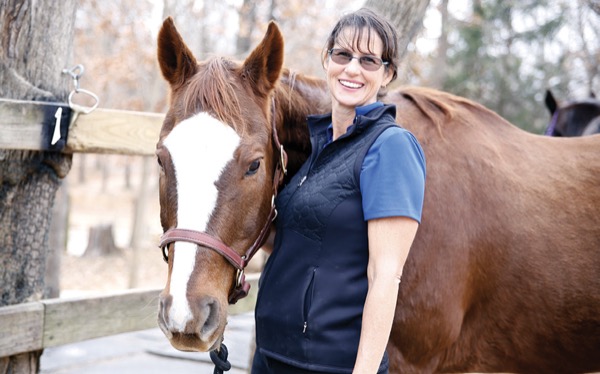LOPE ALONG
Learn the ABCs of
this three-beat gait.
this three-beat gait.
By Cheryl West
with Holly Clanahan
with Holly Clanahan
1-2-3, 1-2-3 … the cadence of the lope is unmistakable and just plain fun to ride. But it’s important to have a full understanding of this gait, so you can ride it to the best of your ability and help keep your horse in his best balance.
First, what exactly is this three-beat gait? Western riders most commonly call it a lope, while English or dressage riders refer to it as a canter, and their version may have a bigger stride. Horses lope in either a right lead or a left lead, depending on which direction they will be turning or circling. If you’re riding to the left in an arena (meaning that your left shoulder is toward the center of the arena and your right shoulder is toward the fence), your horse should lope in his left lead.

Here’s how a left lead comes together: The horse will first step off with his right, or outside, hind leg. The second footfall is the diagonal pair of his left hind foot and right front foot landing together. Then finally, his left front leg will finish the stride. A brief moment of suspension – all four legs in the air – occurs before his right hind leg strikes the ground again. The reverse is true for a horse loping on his right lead.
A fun way to teach leads is to put numbers on four cups and let students play with those to see how the footfall of the lope really works. Adults love these games as much as kids. I’ve also seen two people strap cans to their feet, and one person plays the front feet, while the other acts as the hind feet.
Once you’re in the saddle, how do you know what lead you’re on? First, don’t lean down and look at your horse’s shoulders. It’s a bad habit, and it could cause your horse to break gait or stumble because your weight just shifted too far forward. Plus, it makes it impossible to sit on your seat bones – which you need to be doing to correctly feel your leads.

Heidi Melocco
This photo illustrates the first footfall in a left-lead sequence. With the right hind on the ground, you can see that the left hind/right front diagonal will strike next. The left front will be the final footfall.
Instead, sit in the saddle with your weight directly over your seat bones (something that is correct, no matter what discipline you ride). You should feel your body matching your horse’s. If he’s loping on his left lead, your left hip will come slightly more forward than your right hip. Your shoulders should remain square so your reins can stay even.
That same principle comes into play when you ask your horse to lope in a certain lead. When you’re asking for a left lead, your right seat and your right leg are going to move backward just a bit and ask the right hip to lope, because that’s the horse’s first step. That’s why we put our outside leg on.

As the horse steps into the lope, you should feel your left hip come forward, matching the inside hip and right shoulder. As you squeeze and lift with your legs, you’ll feel the final step, which is the horse’s left shoulder moving forward.
If you’re having trouble with the lope, always look to yourself first to see if your cues are clear and consistent, and if your body position is correct. Arena mirrors and videotaping your rides can help with this awareness, and watching instructional YouTube videos can also be helpful. But nothing is better than an instructor to help you in the moment, so that you and your horse can both be soft and balanced for a lovely lope.

Holly Clanahan

Cheryl West of Sand Springs, Oklahoma, is certified in both western and English instruction by the Certified Horsemanship Association, an AQHA alliance partner. Go to www.chainstructors.com to find an instructor near you.
AQHA Professional Horsemen are also great coaches. Go to www.aqha.com/prohorsemen to search this list.

